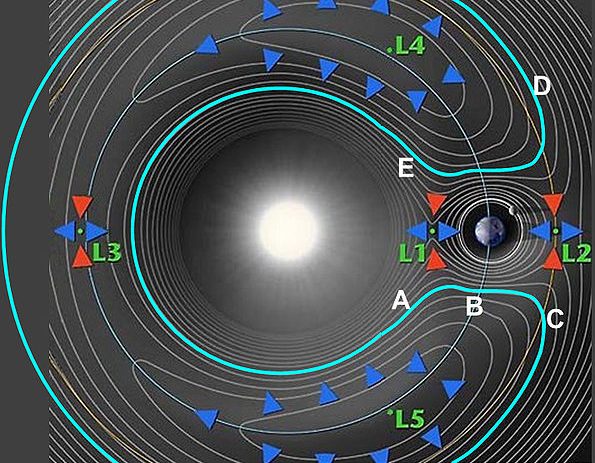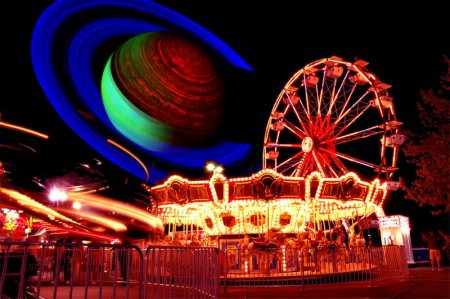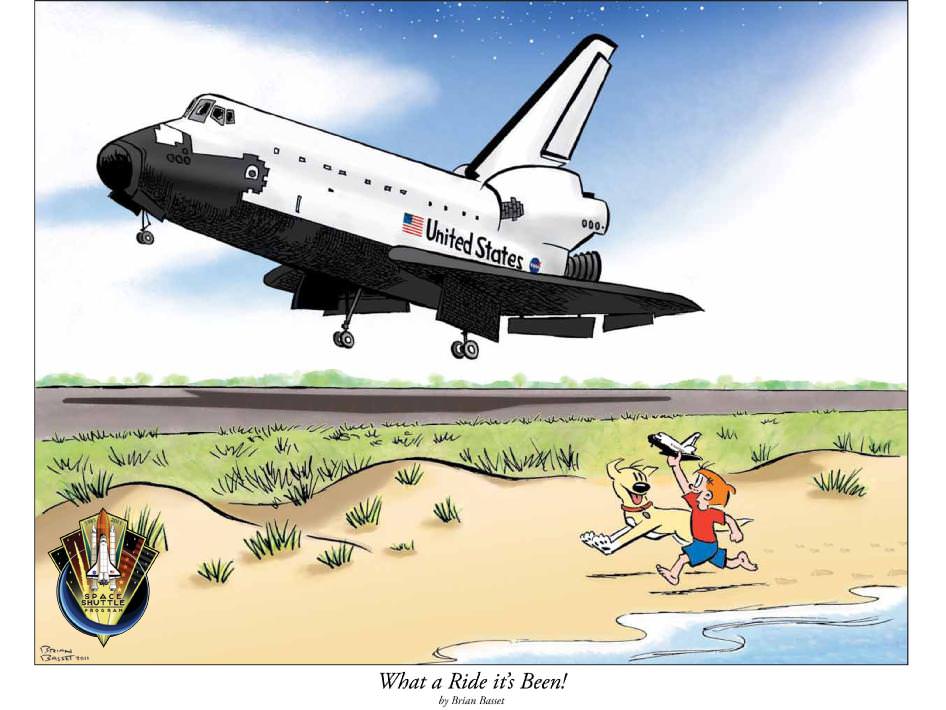I see the folks attending the third .astronomy (dotastronomy) conference this year have been busy — hacking away and creating all sorts of ingenious tools, websites and … songs. Here’s astronomer Amanda Bauer and her band of renown with their new song, “Pluto the Previous Planet.”
Continue reading “New Hit Single: “Pluto the Previous Planet””
Clyde Tombaugh’s Ten Special Commandments for Planet Hunters
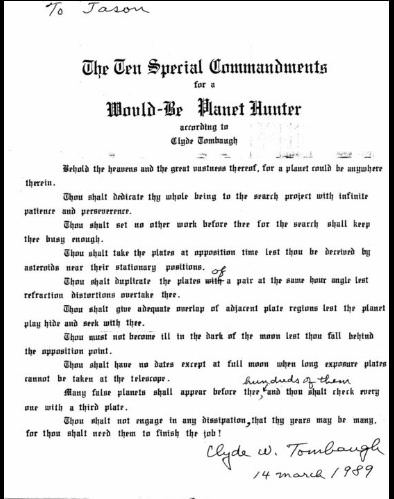
[/caption]
Back in 1989, amateur astronomer Toney Burkhart found out that Clyde Tombaugh was going to be giving a talk in San Francisco, just a short distance from Burkhart’s home. Trouble was, he found out only about 10 minutes before the presentation was going to start, so he rushed over and arrived just in time to hear Tombaugh’s talk, where he told amusing stories of how he found Pluto, and what he went through with night after night in a cold observatory taking photographs and comparing the glass plates, looking for a planet in the outer solar system. Then Tombaugh shared read his version of the Ten Commandments, called, “Ten Special Commandments for a Would-Be Planet Hunter.”
Afterward, the posters of the Commandments were being sold as a fund raising event.
“Clyde was going around the country to raise money for scholarships for young people to study planetary science,” Burkhart told Universe Today. “There were a lot of people there in the lobby buying posters autographed by Clyde Tombaugh and I wanted one very much.”
However, when Burkhart went to purchase one, he discovered that in his haste to leave his home, he had forgotten his billfold.
“I waited until everything was over and thought that I would at least go over and say hi to Clyde and tell him how much I thought of his hard work and to shake his hand, at least,” Burkhart said, and Tombaugh was more than happy to chat with an fellow astronomy enthusiast.
“While I was chatting with Clyde, I told him that I wish I brought money to buy one of the posters. He looked at me and smiled and said, ‘Well, that’s alright.’” And I said no, I really would have bought one if I had not ran out of the house and forgot my billfold. He was holding his notes and I asked him, what are you going to do with those notes, throw them away?”
Burkhart said Tombaugh smiled and replied that he couldn’t give away his notes, as he had more talks to give, but said he could mail them to Burkhart after his tour was over.
Burkhart offered to send Tombaugh a check later, or at least pay for postage, but Tombaugh looked at him and said, “No, that’s OK, I see you are really into astronomy and it would be my pleasure to give it you.”
Grateful, Burkhart asked if Tombaugh could autograph it, not for Burkhart but for his son Jason. Tombaugh took Burkhart’s address, and true to his word, about a month later Burkhart received Tombaugh’s personal version of the Commandments, with corrections made in pen, (the corrections were made by Tombaugh’s wife, Patricia, Burkhart said) along with his autograph. “I have them in safekeeping to leave to my son to have and hopefully give them to his kids,” Burkhart said.
Here are the the Ten Special Commandments for a Would-Be Planet Hunter, according to Clyde Tombaugh
1. Behold the heavens and the great vastness thereof, for a planet could be anywhere therein.
2. Thou shalt dedicate thy whole being to the search project with infinite patience and perseverance.
3. Though shalt set no other work before thee for the search shall keep thee busy enough.
4. Though shalt take the plates at opposition time lest thou be deceived by asteroids near their stationary positions.
5. Though shalt duplicate the plate of a pair at the same hour angle lest refraction distortions overtake thee.
6. Thou shalt give adequate overlap of adjacent plate regions lest the planet play hide and seek with thee.
7. Thou must not become ill in the dark of the moon lest thou fall behind the opposition point.
8. Thou shalt have no dates except at full moon when long exposure plates cannot be taken at the telescope.
9. Many false planets shall appear before thee, hundreds of them, and thou shalt check every one with a third plate.
10. Thou shalt not engage in any dissipation, that thy years may be many for thou shalt need them to finish the job!
Clyde W. Tombaugh
14 March 1989
Burkhart shared the scan of Tombaugh’s notes on his Facebook page.
h/t to Charles Bell.
Coalition for Space Exploration Tasks us to “Think Outside the Circle”
The aerospace industry is typically filled with engineers, scientists and pilots. Hardly the segment of the population that is subject to expounding on the virtues of their trade in prose or through some other format. That said, every once and a while, a campaign, image or video comes along that simply nails what the men and women of the industry have been trying to say. Continue reading “Coalition for Space Exploration Tasks us to “Think Outside the Circle””
Earth Has A Companion Asteroid With a Weird Orbit
[/caption]
There are plenty of near-Earth asteroids out there, but this latest one studied by two researchers at Armagh Observatory in Northern Ireland is extremely rare in that it has a weird, horseshoe-shaped orbit. Not that Asteroid 2010 SO16 does an about-face and turns around in mid-orbit — no, the asteroid always orbits the Sun in the same direction. But because of its unique orbital path and the gravitational effects from both the Earth and the Sun, it goes through a cycle of catching up with the Earth and falling behind, so that from our perspective here on Earth, its movement relative to both the Sun and the Earth traces a shape like the outline of a horseshoe: it appears to approach, then shift orbit, and go farther away without ever passing Earth.
This asteroid was discovered on September 17, 2010 by the WISE Earth-orbiting observatory.
There are only a handful of other asteroids known to have a horseshoe orbit. But astronomers Apostolos Christou and David Asher say 2010 SO16’s absolute magnitude (H=20.7) makes this the largest object of its type known to-date. It is just a few hundred meters across, so the other asteroids are extremely small, and none of the other horseshoe asteroids have orbits that are likely to survive for more than a few thousand years. But the researchers did computer simulations of SO16’s orbit, which showed it could stay in its orbit for at least 120,000 years, maybe more.
For an asteroid to have such an orbit means it is in almost the same solar orbit as Earth, and both take approximately one year to orbit the Sun.
The Technology Review Blog explained it this way:
“Two points are worth bearing in mind. First, objects further from the Sun than Earth, orbit more slowly. Second, objects that are closer to the Sun orbit more quickly than Earth.
So imagine an asteroid with an orbit around the Sun that is just a little bit smaller than Earth’s. Because it is orbiting more quickly, this asteroid will gradually catch up with Earth.
When it approaches Earth, the larger planet’s gravity will tend to pull the asteroid towards it and away from the Sun. This makes the asteroid orbit more slowly and if the asteroid ends up in a orbit that is slightly bigger than Earth’s, it will orbit the Sun more slowly than Earth and fall behind.
After that, the Earth will catch up with the slower asteroid in the bigger orbit, pulling it back into the small faster orbit and process begins again.
So from the point of view of the Earth, the asteroid has a horseshoe-shaped orbit, constantly moving towards and away from the Earth without ever passing it. (However, from the asteroid’s point of view, it orbits the Sun continuously in the same direction, sometimes more quickly in smaller orbits and sometimes more slowly in bigger orbits.)”
Right now, SO16 is near one of its closest points of approach, chasing the Earth on its inside orbit. It will be tagging along near Earth for the next few decades until it is pulled all the way over into the outside orbit and it slowly recedes from view.
The researchers say the existence of this long-lived horseshoe raises the twin questions of its origin and whether objects in similar orbits are yet to be found. Additionally, they suggest that SO16 may be a suitable test target for the direct detection of the Yarkovsky acceleration as it makes frequent close encounters with the Earth during the next decade.
Paper: “A long-lived horseshoe companion to the Earth”
Sources: Technology Review Blog, Wikipedia
Watch How Curiosity Will Land On Mars
Entry, descent and landing is the big moment for any Mars lander mission, and the big honkin’ Mars Science Lab and its sky-crane landing system will truly be unique. This brand new video from the Jet Propulsion Lab shows how MSL, a.k.a Curiosoity will land on the Red Planet in August of 2012. Doug Ellison, part of the team who worked on this computer generated video told Universe Today that the scenes from Mars shown here were created from real elevation data from the HiRISE camera on the Mars Reconnaissance Orbiter, and the outcrop of rock that Curiosity visits is based on Burns Cliff, visited by Opportunity in 2004.
Continue reading “Watch How Curiosity Will Land On Mars”
NASA Researchers Find Brand New Mineral in Old Meteorite
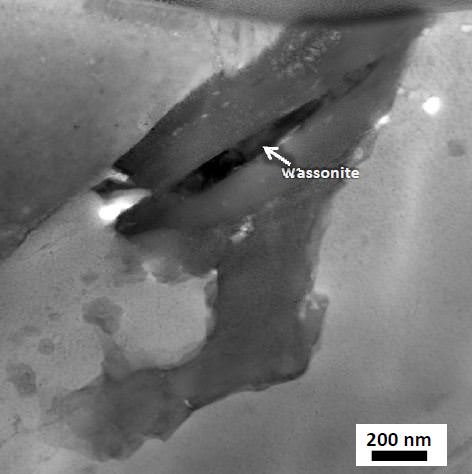
[/caption]
It’s a brand new mineral, and it’s from space. Researchers taking a new look at an old meteorite with a high-tech electron microscope have found a new mineral, now called Wassonite, in a space rock found in Anarctica back in 1969, the Yamato 691 enstatite chondrite. The meteorite likely originated from the Asteroid Belt between Mars and Jupiter and is about 4.5 billion years old.
“Wassonite is a mineral formed from only two elements, sulfur and titanium, yet it possesses a unique crystal structure that has not been previously observed in nature,” said Keiko Nakamura-Messenger, a NASA scientist who headed the research team.
Wassonite now joins the list of 4,500 official minerals, approved by the International Mineralogical Association. It was named after meteorite researcher John T. Wasson, from the University of California, Los Angeles (UCLA).
But there could be more unknown minerals inside the meteorite. The researchers found Wassonite surrounded by additional minerals that have not been seen before, and the team is continuing their investigations.
The amount of Wassonite in the rock is less than one-hundredth the width of a human hair or 50×450 nanometers wide. Without NASA’s transmission electron microscope, which is capable of isolating the Wassonite grains and determining their chemical composition and atomic structure, the mineral would have been impossible to see.
In 1969, members of the Japanese Antarctic Research Expedition discovered nine meteorites on the blue ice field of the Yamato Mountains in Antarctica. This was the first significant recovery of Antarctic meteorites and represented samples of several different types. As a result, the United States and Japan conducted systematic follow-up searches for meteorites in Antarctica that recovered more than 40,000 specimens, including extremely rare Martian and lunar meteorites.
“More secrets of the universe can be revealed from these specimens using 21st century nano-technology,” said Nakamura-Messenger.
“Meteorites, and the minerals within them, are windows to the formation of our solar system,” said Lindsay Keller, space scientist at NASA’s Johnson Space Center in Houston, who was the principal investigator of the microscope used to analyze the Wassonite crystals. “Through these kinds of studies we can learn about the conditions that existed and the processes that were occurring then.”
For more information see this NASA pdf. which provides more images and details about the Wassonite detection.
Carnival of Space #191
This week’s Carnival of Space is hosted by Emily Lakdawalla over at the Planetary Society Blog.
Click here to read Carnival of Space #191.
And if you’re interested in looking back, here’s an archive to all the past Carnivals of Space. If you’ve got a space-related blog, you should really join the carnival. Just email an entry to [email protected], and the next host will link to it. It will help get awareness out there about your writing, help you meet others in the space community – and community is what blogging is all about. And if you really want to help out, sign up to be a host. Send and email to the above address.
SpaceX Unveils Launch of Falcon Heavy, Worlds Most Powerful Rocket by 2013

[/caption]Elon Musk, the CEO and chief rocket designer of Space Exploration Technologies (SpaceX) announced today (April 5) that SpaceX will build and launch the world’s most powerful rocket – dubbed the Falcon Heavy – within two years.
Musk said that he expects SpaceX will launch the first Falcon Heavy by late 2012 or early 2013 from Vandenberg Air Force Base, California.
“We are excited to announce the Falcon Heavy and only recently completed the design,” said Musk.
“Falcon Heavy will carry more payload to orbit or escape velocity than any vehicle in history, apart from the Saturn V moon rocket, which was decommissioned after the Apollo program. This opens a new world of capability for both government and commercial space missions.”
Musk unveiled the design plans for the privately developed, 227 foot tall heavy lift rocket at a briefing for reporters at the National Press Club in Washington, DC.
“This is a rocket of truly huge scale.”
Falcon Heavy would lift from 100,000 to 120,000 pounds to orbit, about three times the performance of the Falcon 9. It is comprised of three nine- engine Falcon 9 first stage booster cores and would utilize upgraded Merlin 1D engines currently being tested at the SpaceX rocket development facility in McGregor, Texas. The Falcon booster cores would be the first to have cross feed propellant capability enabling significant enhancements in payload performance, Musk explained.
“We expect to launch a lot, maybe 20 launches per year,” said Musk. He thinks that the launches would be spilt about equally between the current Falcon 9 and the new Falcon Heavy allowing SpaceX to compete in the full gamut of opportunities for commercial rocket providers. The Falcon Heavy could even be used for interplanetary science missions to Mars and elsewhere in the Solar System (watch for follow up article).
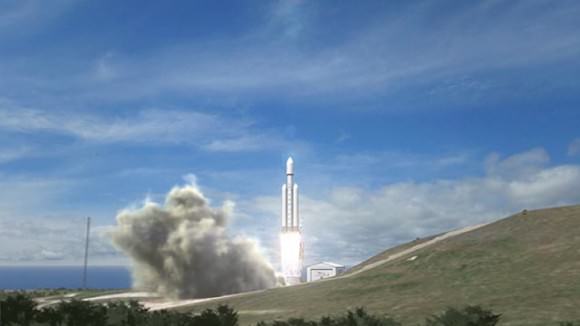
The Falcon Heavy would also be launched from Cape Canaveral after upgrading the existing Falcon 9 pad at the Cape. Indeed a majority of launches is expected from Florida vs. California.
SpaceX is in discussions with NASA to also possibly use one of the shuttle pads at Launch Complex 39 at the Kennedy Space Center. Both launch pads will be vacant after the shuttle stops flying later this year.
“First launch from our Cape Canaveral launch complex is planned for late 2013 or 2014,” Musk said.
The new heavy lift booster will have twice the performance capability of NASA’s retiring Space shuttle fleet or the Delta IV Heavy according to Musk.
“The Falcon Heavy will have more payload capability than any rocket since the Saturn V moon rocket.”
Musk said the Falcon Heavy will be dramatically cheaper and more cost effective compared to current rockets and set new world records in affordability and cost per pound. “The cost will be about $1000 per pound to orbit.” That price is a long sought and near mythical goal. It is also a critical selling point during these times of flat, very tight and declining budgets.
SpaceX says they are offering the Falcon 9 for some $50-60M and the Falcon Heavy for $80-$125M per launch. They say this compares to the projected Air Force average cost of $435M per launch for the 2012 budget year.
“The Falcon Heavy will be about one third the cost of the Delta IV Heavy and with twice the performance. That’s about 6 times more cost effective,” Musk stated. “That’s a pretty huge leap in capability.”
SpaceX will finance the cost of the first demonstration launch. The rocket will only loft several small payloads unless some organization is willing to take a gamble for a reduced cost. Without being specific, Musk added that SpaceX has had “strong interest from U.S. government agencies and commercial entities” for the second launch and beyond. “No one wants to be first.”
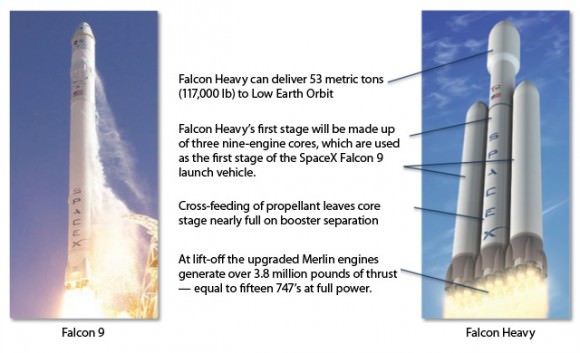
Ensuring reliability is key to SpaceX future. Musk explained that the Falcon Heavy is also designed to meet NASA human rating standards, unlike other satellite launch vehicles. The rocket is designed to meet higher structural safety margins of 40% above flight loads, rather than the 25% level of other rockets, and triple redundant avionics.
To date, SpaceX has launched two Falcon 9 rockets. NASA has awarded SpaceX with a $1.6 billion contract to conduct a minimum of twelve Falcon 9 flights with the Dragon spacecraft to deliver at least 20,000 kg of cargo to resupply the International Space Station (ISS) after the Space Shuttle is retired.
Musk said that there is a lot to be learned and applied from using high volume production techniques used in the automotive industry while maintaining stringent quality control.
The date of the frist Falcon Heavy launch is expected to depend greatly on regulatory requirements, just like the maiden launch of the Falcon 9.

Watch a SpaceX YouTube video about Falcon Heavy here:
Cartoon Commemorates Shuttle Program
[/caption]
“Red and Rover” pay tribute to the space shuttle program, racing alongside the space shuttle as it lands for the final time later this year. Cartoonist and space exploration supporter Brian Basset created this commemorative drawing for NASA, to honor the shuttles. A poster commemorating the program’s 30th anniversary will feature Basset’s cartoon and a patch selected as part of a contest among NASA employees to honor the program.
“The U.S. space program has been the one constant throughout my entire life,” Basset said. “I was humbled and honored when given the opportunity to create the art for the commemorative Space Shuttle Program 30th anniversary poster.”
“Red and Rover” is a great cartoon series about the unconditional love between a boy and his dog. The two often dream of going to space together. But it won’t be on a space shuttle.
Download a copy of the cartoon/poster, and learn more about the it and Basset at this NASA link, and the press release.
Just How Active is our Sun Now Compared to Two Years Ago?
This video provided by the Solar Dynamics Observatory provides a side-by-side comparison of the Sun from precisely two years ago (left, from SOHO in 2009) to the present (right, from Solar Dynamics Observatory, showing March 27-28, 2011) which dramatically illustrates just how active the Sun has become. The comparisons shown in two similar wavelengths of extreme ultraviolet light, reveal how the Sun now sports numerous active regions that appear as lighter areas that are capable of producing solar storms. Two years ago the Sun was in an extremely quiet solar minimum. The Sun’s maximum period of activity is predicted to be around 2013, so activity will likely continue to ramp up.

